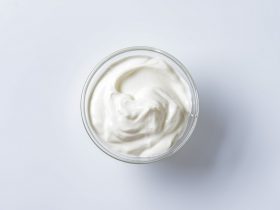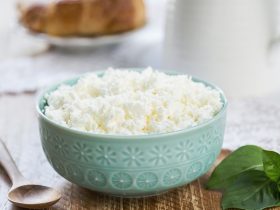Protein requirements increase significantly during pregnancy. From 46 grams per day in the non-pregnant state, recommendations become 60 grams per day for pregnant women. This means an increase of daily protein intake from 0.8 gram per kilogram to 1.1 grams per kilogram body weight during pregnancy (Kominiarek & Rajan, 2016).
Tofu is an example of a protein-rich food that is recommended for pregnant women to eat. It is a good source of plant protein and other nutrients and, together with other soy foods, has been found to have health benefits during pregnancy. However, there are also certain risks involved in its consumption.
What is Tofu?

Tofu is a soy bean curd made from curdled soy milk. It can be bought as packages of bricks with different textures. It also absorbs any flavour used during cooking.
Soy is a popular dish in Southeast Asian culture (Rizzo, 2020). It is an essential food ingredient of traditional Asian cooking used for over a millennium. In Western nations, soy beans were introduced around 100 years ago (Rizzo & Baroni, 2018).
Global producers of soy beans are the USA, Brazil, Argentina, China and India. In Europe, Italy has the highest production of soy beans, with over 900 thousand tons per year. They are mostly utilized for surrogate foods production (Rizzo & Baroni, 2018).
Soy food varieties are commonly used in creating meat analogs and milk substitutes, for vegetarian and self-conscious consumers (Rizzo, 2020).
Benefits of Eating Soy Dishes
Soy is a unique source of vegetable protein. Compared to other legumes, soy is high in protein but low in carbohydrate content (Hoffman & Falvo, 2004). Soy beans are also rich in B vitamins, fiber, iron, calcium, and zinc (Rizzo & Baroni, 2018).
In addition, soy foods are a good source of unsaturated fatty acids, in particular linoleic acid, an omega-6 polyunsaturated fatty acid (PUFA) known to be beneficial for human health. Reported possible benefits of soy include reduction in cholesterol, anti-carcinogenic effects, and protection against obesity, diabetes, bone and kidney diseases (Friedman & Brandon, 2001).
Soy foods, including tofu and soy milk, contain high levels of isoflavones (Ding et al., 2016). Isoflavones provide protective benefits from non-communicable diseases, and are said to involve anti-inflammatory, antineoplastic, antiplatelet and antioxidant mechanisms (Rizzo, 2020).
Compared to other food sources, isoflavones are rich and uniquely found in soy (Bhagwat et al., 2008). Isoflavones have been linked to positive health effects, such as prevention of hormone-related cancer, cardiovascular disease, osteoporosis, and adverse postmenopausal symptoms, as well as improvement in cognitive function (Ko, 2014).
Cardiovascular Disease
Soy isoflavones are phytosterols, which have been reported since 1958 to have a cholesterol-lowering effect (Rizzo & Baroni, 2018). In 1999, the US Food and Drug Administration (FDA) released a report claiming that soy foods are able to lower levels of cholesterol. However, just recently, new evidence found otherwise, hence a revocation of this claim was proposed (Rizzo, 2020).
Soy foods have also been linked to reduction of coronary heart disease (CHD) (Messina, 2016). Soy isoflavones have been continuously studied for their potential antioxidant properties. It has been proposed that isoflavones promote anti-atherosclerotic effects through scavenging of lipid peroxyl radicals (Patel et al., 2001).
Epidemiological data show that consumption of soy isoflavone could be the reason for different CHD rates between Asian and Western countries (Rizzo & Baroni, 2018). Yan et al. in 2017 demonstrated in a meta-analysis that overall soy intake was associated with reduced risk of cardiovascular disease, stroke and CHD.
In 2000, the Nutrition Committee of the American Heart Association released a statement about the protective effect of soy against CHD (Erdman, 2000). However, in 2012, the European Food Safety Authority (EFSA) stated that there is no clear cause and effect relationship between soy and lowering of serum LDL concentration (Rizzo & Baroni, 2018).
Other beneficial effects to health associated with isoflavones are prevention of hypertension, hypercholesterolemia, obesity and oxidative stress (Rizzo & Baroni, 2018).
Diabetes Mellitus
Protection against oxidative stress influences glycemic tolerance (Rizzo, 2020). In 2012, Mueller et al. made a study on Chinese Singaporean men and women aged 45 to 74 years old who were free of chronic diseases at baseline beginning 1993 to 1998. They followed them up until 2004 and investigated on their soy intake and development of diabetes mellitus.
Their findings revealed that intake of unsweetened soy foods and isoflavones has a protective role for risk of type 2 diabetes. Conversely, consumption of sweetened soy bean drinks was positively linked to increased risk of diabetes (Mueller et al., 2012).
In 2016, Ding et al. demonstrated that isoflavone intake was associated with a modest reduction in the risk of development of type 2 diabetes among people who consume low to moderate amounts of soy foods.
Cancer
Flavonoids and their antioxidative effect may protect against cancer development in which free radicals play a role (Rizzo & Baroni, 2018). According to Messina in 2016, soy foods have been linked to reduction of breast and prostate cancer.
In 2020, Wang et al. demonstrated that tofu consumption decreases the risk of breast cancer. Likewise, in 2021, Shirabe et al. showed that fermented soy foods were associated with reduced risk of nonlocalized breast cancer.
Moreover, in 2009, Yang et al. concluded that eating soy foods may decrease the risk of development of colorectal cancer among postmenopausal women.
Benefits of Soy for Pregnant Women

Assisted Reproduction
Even for women who are yet to become pregnant, but wishes to have a baby through assisted reproduction, soy intake was found to be of benefit. In 2015, Vanegas et al. showed that in over 300 women who underwent cycles of assisted reproductive technology (ART) from 2007 to 2013, consumption of soy foods was positively associated with higher rates of live birth.
Depression
In 2018, Miyake et al. investigated the effect of soy consumption on prevalence of depression during pregnancy in Japan. Over a thousand pregnant women participated in the study. Results showed that higher intake of soy products, tofu, tofu products, fermented soy beans, boiled soy beans, miso soup, and isoflavones was significantly associated with fewer depressive symptoms during pregnancy.
Gestational Diabetes
In 2014, Fei et al. made a randomized controlled trial involving 97 pregnant women with gestational diabetes mellitus (GDM). Their findings revealed that soy bean oligosaccharides reduced oxidative stress and improved insulin resistance. Therefore, soy intake may play a role in the control of GDM and its complications.
Likewise, in 2015, Jamilian & Asemi showed that soy protein intake in women with GDM led to significantly decreased fasting plasma glucose and serum insulin levels. Moreover, soy protein consumption significantly improved the participants’ glucose homeostasis parameters, triglycerides, and biomarkers of oxidative stress.
Infant Health
Hypospadias is a congenital malformation in which the urethral opening occurs on the anterior side of the penis. Experimental data show that maternal exposure to estrogenic compounds may affect the risk of developing hypospadias in the infant.
Phytoestrogens are estrogenic compounds most commonly consumed by humans from soy bean-derived foods that are rich in isoflavones. Phytoestrogens are less potent than estradiol but they act in the human body through similar mechanisms of action (Jefferson et al., 2012).
In 2013, Carmichael et al. analysed data from over 1,000 mothers who delivered infants with hypospadias between 1997 and 2005, together with over 3,000 mothers who served as controls. They concluded that higher intake of isoflavones and phytoestrogens reduced the risk of mothers delivering newborns with hypospadias. However, lower overall intake of phytoestrogens was not associated to increased risk.
Further, in 2015, Jamilian & Asemi found reduced incidence of infant hyperbilirubinemia and hospitalizations with maternal exposure to soy foods.
Potential Risks from Soy Consumption
Possible adverse effects of soy consumption include poor digestibility and allergy to soy proteins (Friedman & Brandon, 2001). Links to cadmium exposure have also been reported. Cadmium is an environmental pollutant associated with impairment of renal function and other diseases (Adams et al., 2011).
In 2011, Adams et al. investigated sources of cadmium exposure and found that cigarette smoking is the most important. However, among nonsmokers, the study concluded that food intake, most notably consumption of tofu, was the most common source of increased cadmium exposure.
Soy contains high concentrations of phytoestrogens, polyphenols with a similar molecular structure as endogenous estrogens in the human body. This particular property raises doubts about the safety of intake of soy, especially at high doses (Ko, 2014).
Despite its many reported health benefits, phytoestrogens are also considered as endocrine disruptors. Therefore, they have the potential to cause harm to human health as well. Their molecular and cellular properties as weak estrogen agonists/antagonists are similar to synthetic endocrine disruptors like Bisphenol A (BPA) (Patisaul & Jefferson, 2010).
Recommendations in Pregnancy
A healthy diet during pregnancy is important for the mother and her growing baby. The best way to get all the extra nutrients needed is to eat a variety of foods and to stick with only healthy foods as much as possible. A balanced diet should include a variety of bread, rice or pasta, vegetables, fruits, meat, eggs and tofu, and milk or dairy.
The Australian Dietary Guidelines recommends 3 ½ servings of protein per day for all pregnant women. These should come from meat, fish, poultry, cooked eggs, nuts, seeds, and tofu. One serving is equivalent to the following common sources of protein as follows:
- 90 to 100 grams raw weight of cooked meat from beef, lamb or pork
- 100 grams raw weight of cooked lean poultry from chicken or turkey
- 115 grams raw weight of cooked fish fillet
- 1 small can of fish
- 30 grams of nuts, seeds or peanut butter
- 2 large eggs
- 170 grams of tofu
To ensure safety of soy products, including tofu, soy milk and soy yoghurt, pregnant women should always check the “best before” date and follow the storage instructions.
Final Thoughts
Tofu and other soy foods are part of a healthy diet in pregnancy. They are good sources of protein and are recommended for a balanced and nutritious intake during pregnancy.
They can provide a number of different health benefits, before, during and after pregnancy. But there are also concerns regarding some risks of soy consumption.
Notably, there are not much official recommendations that have been given specific for the intake of tofu. Therefore, it is best for pregnant women to talk with their health care physicians regarding the best amount to consume specifically for their needs.
References
- https://www.healthline.com/
- https://www.healthline.com/
- https://www.foodauthority.nsw.gov.au/
- Adams, S. Newcomb, P., Shafer, M., Atkinson, C., Bowles, E., Newton, K., & Lampe, J. (2011). Sources of cadmium exposure among healthy premenopausal women. Science of the Total Environment 409(9), 1632-1637. doi: 10.1016/j.scitotenv.2011.01.037
- Bhagwat, S., Haytowitz, D., & Holden, J. (2008). USDA database for the isoflavone content of selected foods: Release 2.0. U.S. Department of Agriculture. https://www.ars.usda.gov/ARSUserFiles/80400525/data/isoflav/isoflav_r2.pdf
- Carmichael, S., Cogswell, M., Ma, C., Feliciano, A., Olney, R., Correa, A., & Shaw, G. (2013). Hypospadias and maternal intake of phytoestrogens. American Journal of Epidemiology 178(3), 434-440. doi: 10.1093/aje/kws591
- Ding, M., Pan, A., Manson, J., Willett, W., Malik, V., Rosner, B., …, & Sun, Q. (2016). Consumption of soy foods and isoflavones and risk of type 2 diabetes: A pooled analysis of three US cohorts. European Journal of Clinical Nutrition 70(12), 1381-1387. doi: 10.1038/ejcn.2016.117
- Erdman, J. W., Jr. (2000). AHA science advisory: Soy protein and cardiovascular disease: A statement for healthcare professionals from the nutrition committee of the AHA. Circulation 102(20), 2555-2559. doi: 10.1161/01.cir.102.20.2555
- Fei, B., Ling, L., Hua, C., Ren, S. (2014). Effects of soybean oligosaccharides on antioxidant enzyme activities and insulin resistance in pregnant women with gestational diabetes mellitus. Food Chemistry 158, 429-432. doi: 10.1016/j.foodchem.2014.02.106
- Friedman, M., & Brandon, D. L. (2001). Nutritional and health benefits of soy proteins. Journal of Agricultural and Food Chemistry 49(3), 1069-1086. doi: 10.1021/jf0009246
- Hoffman, J., & Falvo, M. (2004). Protein: Which is best? Journal of Sports Science & Medicine 3(3), 118-130. https://pubmed.ncbi.nlm.nih.gov/24482589/
- Jamilian, M., & Asemi, Z. (2015). The effect of soy intake on metabolic profiles of women with gestational diabetes mellitus. The Journal of Clinical Endocrinology & Metabolism 100(12), 4654-4661. https://doi.org/10.1210/jc.2015-3454
- Jefferson, W., Patisaul, H., & Williams, C. (2012). Reproductive consequences of developmental phytoestrogen exposure. Reproduction 143(3), 247-260. doi: 10.1530/REP-11-0369
- Ko, K. (2014). Isoflavones: Chemistry, analysis, functions and effects on health and cancer. Asian Pacific Journal of Cancer Prevention 15(17), 7001-7010. doi: 10.7314/apjcp.2014.15.17.7001
- Kominiarek, M., & Rajan, P. (2016). Nutrition recommendations in pregnancy and lactation. Medical Clinics of North America 100(6), 1199-1215. doi: 10.1016/j.mcna.2016.06.004
- Messina, M. (2016). Soy and health update: Evaluation of the clinical and epidemiologic literature. Nutrients 8(12), 754. doi: 10.3390/nu8120754
- Mueller, N., Odegaard, A., Gross, M., Koh, W., Yu, M., Yuan, J., & Pereira, M. (2012). Soy intake and risk of type 2 diabetes mellitus in Chinese Singaporeans. European Journal of Nutrition 51(8), 1033-1040. doi: 10.1007/s00394-011-0276-2
- Miyake, Y., Tanaka, K., Okubo, H., Sasaki, S., Furukawa, S., & Arakawa, M. (2018). Soy isoflavone intake and prevalence of depressive symptoms during pregnancy in Japan: Baseline data from the Kyushu Okinawa maternal and child health study. European Journal of Nutrition 57(2), 441-450. doi: 10.1007/s00394-016-1327-5
- Patel, R. P., Boersma, B. J., Crawford, J. H., Hogg, N., Kirk, M., Kalyanaraman, B., …, & Usmar, V. (2001). Antioxidant mechanisms of isoflavones in lipid systems: Paradoxical effects of peroxyl radical scavenging. Free Radical Biology & Medicine 31(12), 1570-1581. doi: 10.1016/s0891-5849(01)00737-7
- Patisaul, H., & Jefferson, W. (2010). The pros and cons of phytoestrogens. Frontiers in Neuroendocrinology 31i(4), 400-419. doi: 10.1016/j.yfrne.2010.03.003
- Rizzo, G. (2020). The antioxidant role of soy and soy foods in human health. Antioxidants 9(7), 635. doi: 10.3390/antiox9070635
- Rizzo, G., & Baroni, L. (2018). Soy, soy foods and their role in vegetarian diets. Nutrients 10(1), 43. doi: 10.3390/nu10010043
- Shirabe, R., Saito, E., Sawada, N., Ishihara, J., Takachi, R., Abe, S., …, & Tsugane, S. (2021). Fermented and nonfermented soy foods and the risk of breast cancer in a Japanese population-based cohort study. Cancer Medicine 10(2), 757-771. doi: 10.1002/cam4.3677
- Vanegas, J., Afeiche, M., Gaskins, A., Alarcon, L., Williams, P., Wright, D., …, & Chavarro, J. (2015). Soy food intake and treatment outcomes of women undergoing assisted reproductive technology. Fertility and Sterility 103(3), 749-755 e2. doi: 10.1016/j.fertnstert.2014.12.104
- Yan, Z., Zhang, X., Li, C., Jiao, S., & Dong, W. (2017). Association between consumption of soy and risk of cardiovascular disease: A meta-analysis of observational studies. European Journal of Preventive Cardiology 24(7), 735-747. https://doi.org/10.1177/2047487316686441
- Yang, G., Shu, X., Li, H., Chow, W., Cai, H., Zhang, X., …, & Zheng, W. (2009). Prospective cohort study of soy food intake and colorectal cancer risk in women1,2,3. The American Journal of Clinical Nutrition 89(2), 577-583. doi: 10.3945/ajcn.2008.26742




